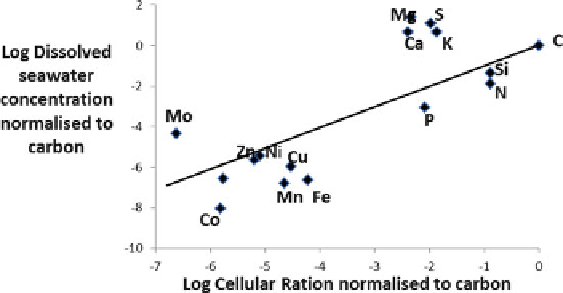Geoscience Reference
In-Depth Information
Fig. 14.6
Plot of the dissolved concentrations of selected elements against their cellular quota
both normalised to carbon and plotted on a log-log basis, based on (Moore et al.
2013
). Note that
the requirements for some elements are variable and can be met by substitution with other metals.
Elements lying above the line are at concentrations above cellular requirements while those below
are deficient and hence may potentially be limiting primary production. To date there is good
evidence for N, P and Fe limitation, but not for the other trace elements
(see below) but the evidence that the supply of these other trace metals plays a
major role in the regulation of ocean productivity is currently limited, although
it may influence species composition (Moore et al.
2013
). Paytan et al. (
2009
)
have suggested that atmospheric supply of other metals such as copper may induce
toxic effects in regions of high dust deposition, although this conclusion has been
questioned because they assumed a very high copper solubility (Sholkovitz et al.
2010
) and also because effective organic complexation of metals such as copper in
ocean waters generally acts to effectively detoxify the metal in the oceans (Chester
and Jickells
2012
).
The recognition of iron as a potential key limiting nutrient has prompted a great
deal of research into iron cycling in the oceans over the last 20 years, summarised
recently by Boyd and Ellwood (
2010
). The ocean biogeochemical cycle of iron is
radically different from that of the macronutrients, due to the relative insolubility
of inorganic Fe(III) and very low dissolved iron concentrations of the order of
1nmoll
1
, about a thousand times less than N and P. The biogeochemistry of
iron is complex with much of the iron organically complexed. This complexation
of iron increases its solubility and residence time, but its ocean residence time
is still only 100-200 years, hence much less than ocean mixing time, and so the
relationship between concentrations and ocean circulation is less evident than for
N and P. Relative to phytoplankton requirements, iron supply for photosynthesis
from the deep ocean iron reservoir is relatively low compared to nitrate and
phosphate supply and is supplemented in many areas by external inputs from shelf
sediments, ice, rivers, anthropogenic emissions to the atmosphere and dust (Jickells
et al.
2005
). The relatively rapid removal of iron from seawater means that ocean
margin inputs from sediments, rivers and ice dominate in coastal areas, where

Search WWH ::

Custom Search